Art Theorist Terry Smith on His New Tome, “Thinking Contemporary Curating”
by Orit Gat, Modern PaintersOriginally Published: September 18, 2012In October, Independent Curators International will publish Terry Smith’s Thinking Contemporary Curating, the first book in a new series about current curatorial perspectives. Smith and ICI are launching the book with a reading from it on September 18 at New York University. Orit Gat talked to him about what makes curators—and the way they think—so different from art historians and critics.
You define yourself as an art historian and as a critic. You mention specifically in the text that you curated very few exhibitions, so what is your stake in writing this book?
To give something back to curators. We all owe them a huge debt. When you’re an art historian, you tend to search museum installations and exhibitions for fresh art historical facts, for something that will help you interpret more deeply, or at least differently, a school of art or the work of an artist over a whole career. If you’re an art critic, you try to write about your response to the works in the exhibition, one by one or one compared to others, with a focus on the artist or a kind of art. But art critics, art historians, the general public, and even artists don’t pay sufficient attention to the curatorial thought behind exhibitions. They tend to assume that it is the same kind of thinking that they do. Thinking Contemporary Curating tries to distinguish what is distinctive about how curators think and what they do, yet also identify what they share with other artworld actors. A couple of recent changes have made this juggling act rather more complex. One is that curators, since Harald Szeemann, Walter Hopps, and others, have become more active, more public thinkers…and call themselves “exhibition makers.” They overtly engage viewers with their thinking about art, and particularly about how art relates to the world—which is something that art itself has done much more since the 1960s and 1970s. Also, curators have become more like artists in the ways they present an exhibition–it then becomes, in a sense, an artwork. At the same time, certain artists are making works of art that are more like exhibitions, and more and more are taking control of exhibiting their own art. Many of the mini-exhibitions that comprise dOCUMENTA (13), for example, were made by the artists. There is a very interesting convergence going on here.
So could we start talking about artists in terms of the curatorial thinking you describe? I’d take for example the practice of someone like Mark Dion whose thinking is about the practice of presentation.
That’s a good example: there’s a wonderful piece by him at dOCUMENTA (13), in the Ottoneum, the natural history museum. He has created a hexagonal chamber, beautifully finished in oak with inlaid signs representing each of the continents. Inside, bookshelves house the “wood library.” Begun in the late eighteenth century, it consists of “books” for each known type of tree. These “books” are actually wooden boxes, with bark covers and spines, which contain replicas of the life cycle of a particular tree. The collection consisted mainly of European trees, so Dion adds six news books: one from each of the five missing continents, plus oak, in homage to Joseph Beuys’s famous project, the planting of 7,000 oak trees in Kassel between 1982 and 1987. Dion’s work is about encyclopedic memory and historical time. In its form, it’s a display within a museum, and also a mini-exhibition within a very large exhibition.
How would you describe curatorial thought as different from other forms of thinking about art, like that of artists?
We’ve got an enormous tradition of artists reflecting on their practice—and often doing so very systematically. If you look at the documents of the history of art, particularly before the twentieth century, and if you include the East and elsewhere outside Europe, they’re mostly statements by artists about the practice of making art and the history of doing so. What I propose in the book is that curators think in and through the making of exhibitions: they look at works of art in terms of their potential exhibition value, they visualize exhibitions beforehand, imagine pathways through them, change things during the installation, and learn from the finalized exhibition. Really, that’s a simple step, by analogy, from saying artists think through the process of making work. For me, artists do think specifically about the mediums or situations they work in, always learning from what the process is telling them about itself as they work through it. They, too, prefigure what it might be like to see this work when it is done, and imagine how it will stand up to other relevant works. Every artist I know pays careful attention to predecessors who have faced similar problems and to the contexts in which they did so. Artists do not necessarily envisage their works in exhibitions, although they may, but if so, it will be after having worked through mediums, situations, and contexts. Curators begin at this point: they are the first to really make artworks public.
<Read full article: BlouinARTINFO>
art in and around South Florida


